This mouse house is about one-quarter-inch scale, where one quarter inch equals one foot; but, then again, mice aren't particular about mixing scales! The closeups to show details also make them appear larger than they really are in real life.
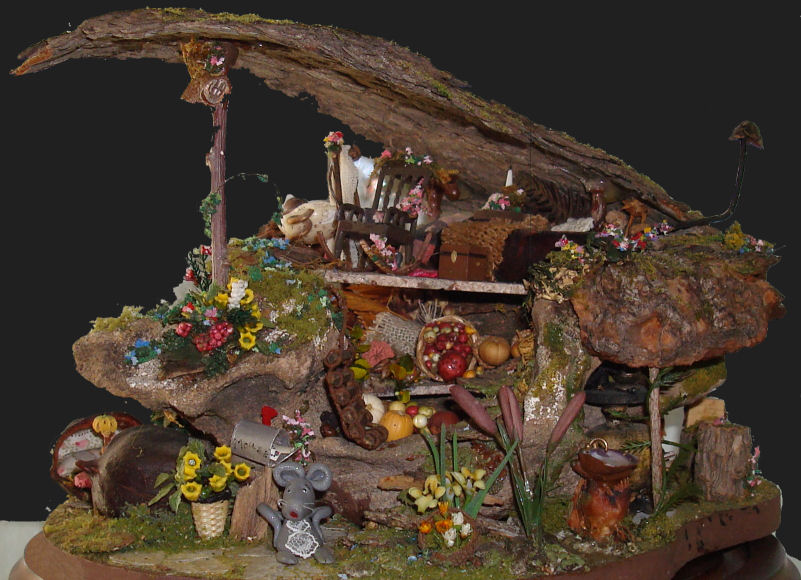
My husband is a volunteer with the Franklin Mountains State Park, which is within the city limits of El Paso, Texas.
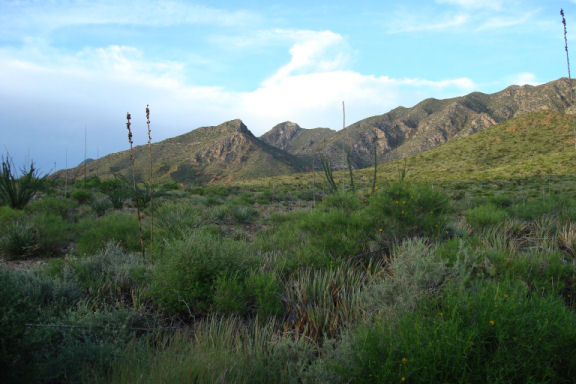
It is at the tail end of the Rocky Mountains, and is the largest urban park in the country. He enjoys hiking, mountain biking, and building mountain bike trails.
On one of his hikes some years ago he discovered a little household of mice residing within a rocky outcropping.
"It was such a surprise; I was intent on watching some turkey buzzards circling in the distance and nearly stepped on one of them. If they hadn't all screamed in unison, I would've crushed Mama with my hiking boot. She was standing some distance away from their little house, watching for the mailman."
I must've snorted or something at that point. "Who delivers mail to mice?"
"What? Well, heck, hon, I didn't think to ask. Do you want me to show you these pictures or not?"
I assured him I did.
"Well, anyway then, they told me they are the Raton de Campo family; Papa, Mama, and Bebe. I knew you'd want to know about them," he said, "so I took some pictures for you - with their permission, of course."
I assured him I was very grateful, as by that time I was practically vibrating with curiosity to see this little country mouse family home.
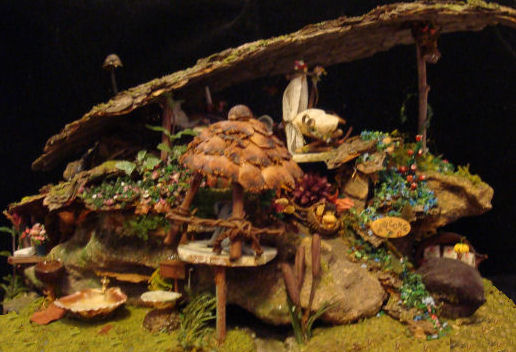
"They were quite hospitable when I promised not to reveal their exact location. 'Not everyone who hikes in these mountains likes mice, you know,' they told me."
I just wished I had been there to talk to them myself, but at least I have his pictures and have so enjoyed studying their little dwelling. He did capture a lot of details, I must say.
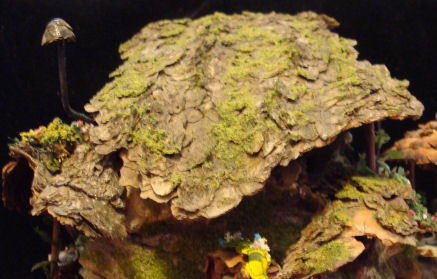
Look at that mossy roof! A lot of people would have a hard time believing that you would see this much moss around El Paso, but they don't realize how many hidden springs there are in our mountains. (That's the chimney from the kitchen stove showing at left.)
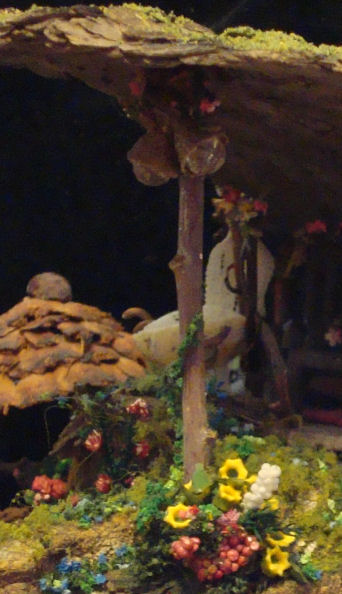
The main roof support for the upstairs section also provides a handy place for some hanging lanterns, although they didn't explain to him how they were lighted.
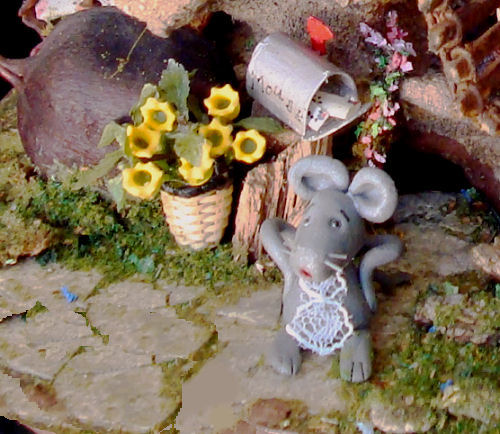
"I didn't want to take too much time with my pictures because Mama Raton de Campo appeared a bit anxious to check her mailbox, " DH said. "She was hoping she'd get a letter that day from her agent about her latest romance novel. I told her you would understand that because you are a storyteller, too."
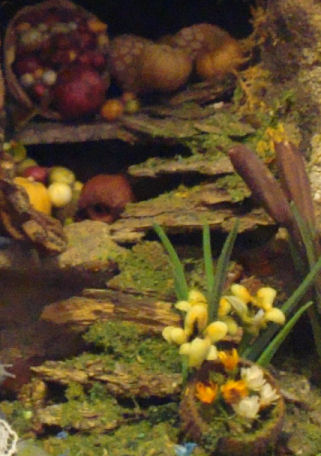
These little steps lead up to the first of two storage areas.
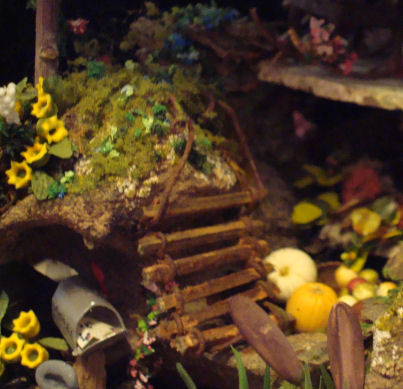
"Oh, come on," I said. "Mice use ladders?"
"Well, what can I say," he shrugged. "Maybe somebody in the family was getting arthritic or something. Maybe there was an Abuelo or Abuelita Raton de Campo somewhere, and they needed it. Anyway, to get back to what I was showing you here in the picture, just past its base they had stored tiny melons and other food items."
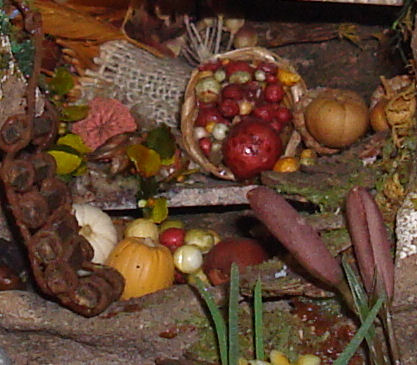
This side has two levels. This is the upper. "Look," he said, pointing toward two pumpkin-like pods. "Recognize those?"
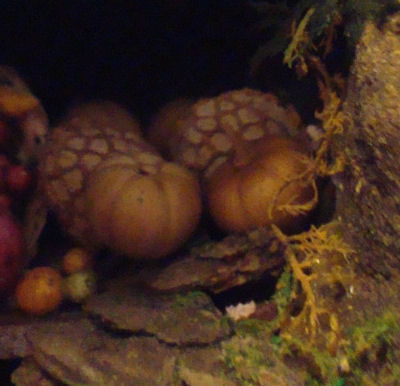
The two pumpkin-like seed pods are just like some that grow wild on small bushes in the red sand hills east of El Paso. I have painted them for other uses as tomatoes and small pumpkins in one-inch scale scenes. Unfortunately, the sand hills are disappearing as neighborhoods creep out that way and so my bushes for pods are disappearing, too. Apparently, those mice found some somewhere!
I was reminded of one night some years ago when I kept hearing little skittering noises from the back room and was fearful that we had mice again. (We had some get into our pantry the previous winter to our dismay.) When I turned on the light, I saw some of these pods on my work table splitting open and shooting little black seeds everywhere - Nature's way of scattering seeds for the next crop. The seeds look a lot like tiny Brazil nuts. Since then, I have tried to remember to coat the pods with a sealer as soon as I get them home. Unless, of course, I WANT the mini Brazil nuts, in which case I put the pods in a sealed jar to catch the seeds as they pop open.
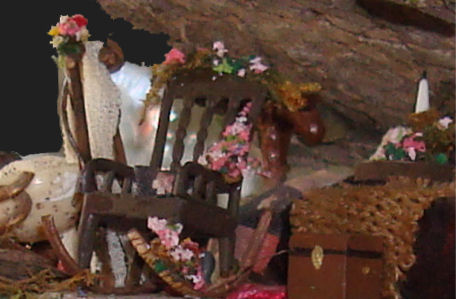
Mama's chair has grapevine rockers and a little pillow for her back. It is very difficult to tell here, but far back under the roof those are Mama and Papa's beds separated by a table in the center.
"Don't worry about that candle," he said. It is not as close to the roof as it appears, he assured me, and of course, Mama is very careful that no one leaves a burning candle unattended.
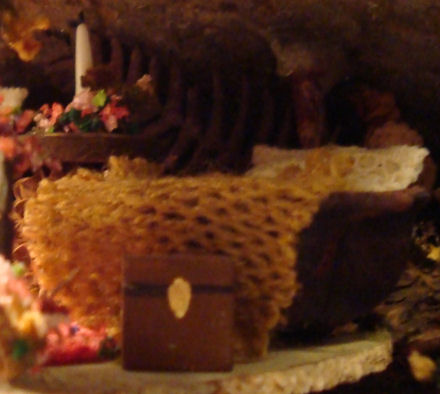
The chest Papa uses for his private papers is at the foot of his bed. "It was so dark that I couldn't get a good picture of their beds, except for Papa's blanket at the end here and a bit of his pillow," he said.
"Oh, wow," I said. "They look like the bottle tree pods that you picked up from under the trees around the hotel where we stayed in Tucson."
"Yup," he said. "They used that same kind of pod for the sofas in their sitting area."
"Hmm," I said. "There aren't any bottle brush trees around here that I know of. So, where do they get them?"
"Well, maybe someone has a tree on the West Side near the Park. Or maybe they have some kind of trading system. All I know is that's what I saw."
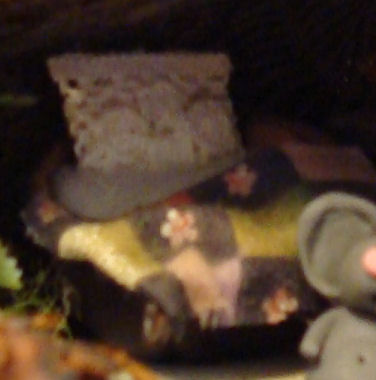
Here's the opposite side of the bedroom with Mama's bed in another pod half. "You're not going to believe this," he said, "But that filmy looking sheet under her quilt is a bit of dryer softener sheet. Now where do you think they would get THAT?" Too bad he didn't get a clearer picture, but I shouldn't complain. Normally, I can't get him to take a camera with him for scenic views, much less detailed pics like these!
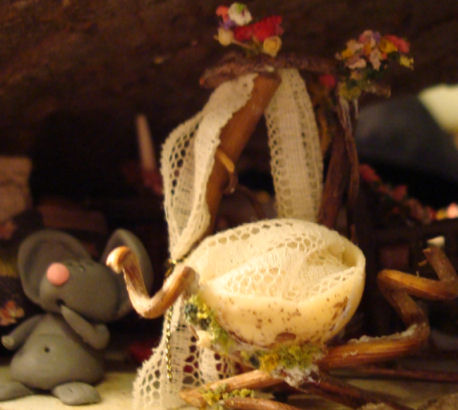
Bebe has almost outgrown his cradle. DH wasn't sure what it was made from; maybe an eggshell of some kind.
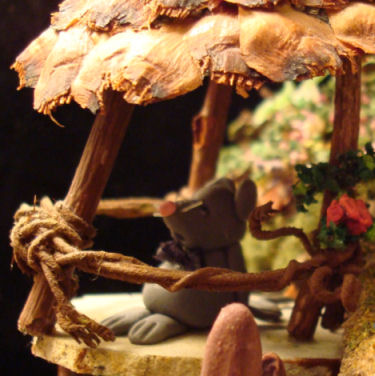
Papa Raton de Campo enjoys communing with nature in the gazebo a few steps down from the bedroom area.
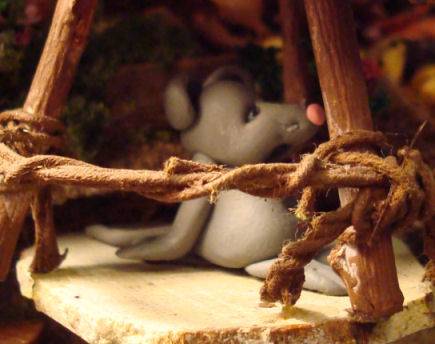
He and my husband had a long discussion about how housing developments are encroaching on lands adjoining the State Park, a subject both of them are quite concerned about, naturally.
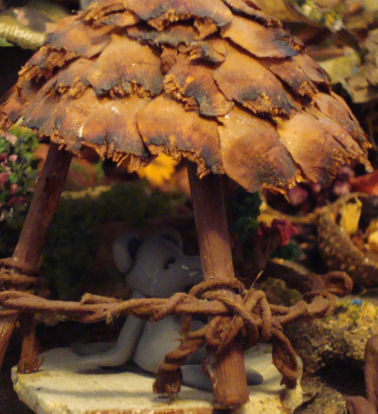
The gazebo has a roof shingled with pinecone petals and its floor is slate, as are the other floors. It tilts a bit, but we have noticed that mice are not too concerned about straight lines.
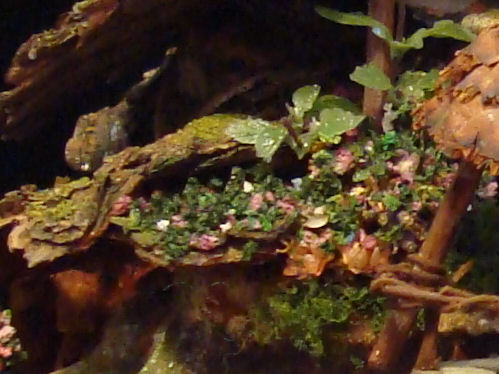
This little rock home is located in a sheltered area in the Franklin Mountains, so it gets more moisture from natural springs there, which explains all the flowers and plant life.
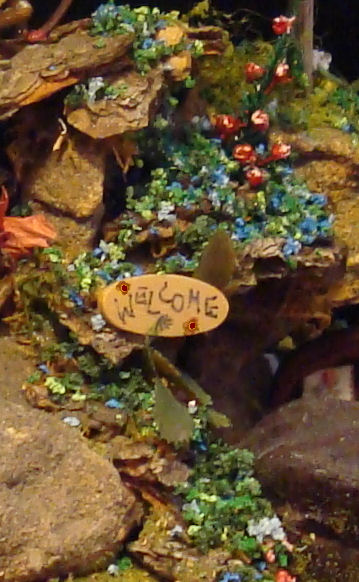
On the opposite side, steps lead up from the lower level past the Welcome sign to another food storage area under the bedroom.
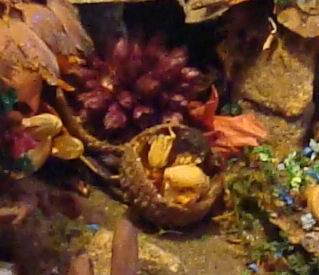
They really believe in keeping a full pantry!
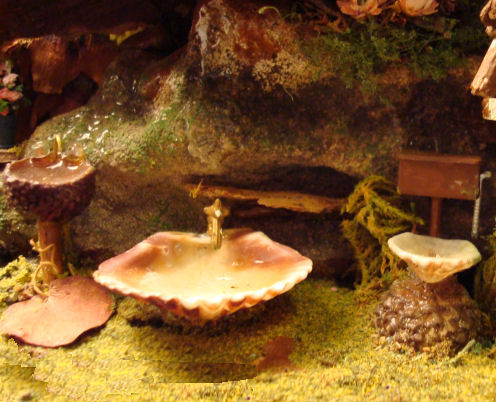
Below and to the left of the gazebo is the bathroom where we can see the mice's ingenious plumbing system at work. My husband explained that water from natural springs within the rock flows down and runs into a cistern under the ledge, then is piped into the appropriate fixtures. Notice how the excess water flows from under the ledge on the upper left, too.
I couldn't help it; I had to ask. "Um, where did they get those seashells?" He just grunted. "Maybe they have some kind of trading system," I mused. "Like the Indians used to for thousands of miles ..."
"Like maybe they went to Mouse Depot or something," he said grumpily. "You think I was going to keep asking such personal questions? I had already asked them too much, knowing you would want to know all the details."
"Sorry, dear," I said, and looked at the next picture.
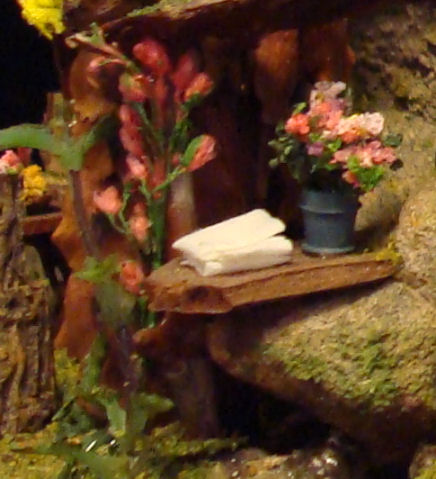
Towels and flowers provide a spa-like atmosphere. Mice are much cleaner than I realized. I hate to admit it, but I have such a prejudice against city mice, after they got into our house that winter.
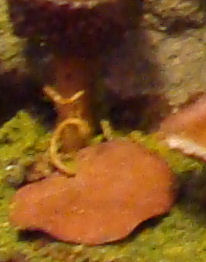
A leaf forms a handy bathmat beside the tub.
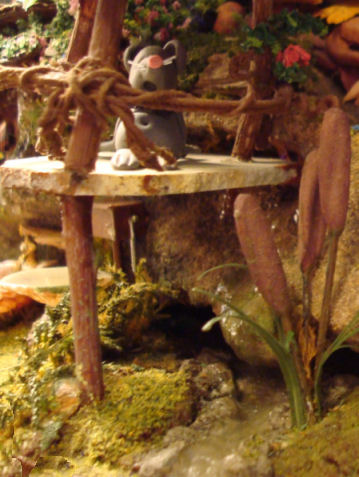
Plants lining a stream that emerges under the gazebo provide a natural cleansing action for waste water as it flows away from the home. The mice are ensured of a hygienic, practical water supply and disposal system.
"Now why can't human beings be this creative," DH mused.
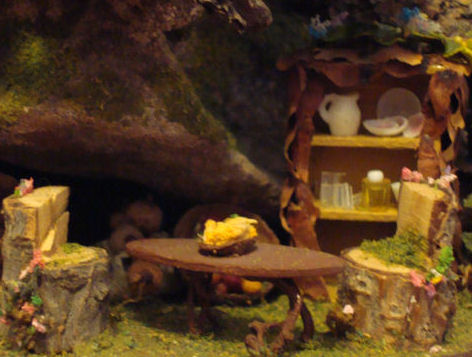
Just around the corner on the ground level is the mouse family's dining room.
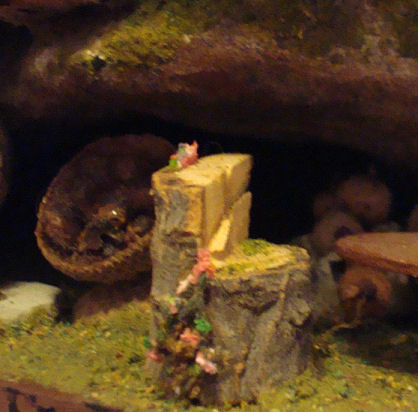
"Notice more food stored in the acorn basket and piled under the rock ledge," DH said. "I told you they were thrifty, didn't I?"
"Hey," I said. "Their chairs look like the ones I made from a small branch you cut from a tree in our back yard when you were pruning." (He is such a doll; before he throws anything away, he always calls, "Hey, you think you could use anything here?")
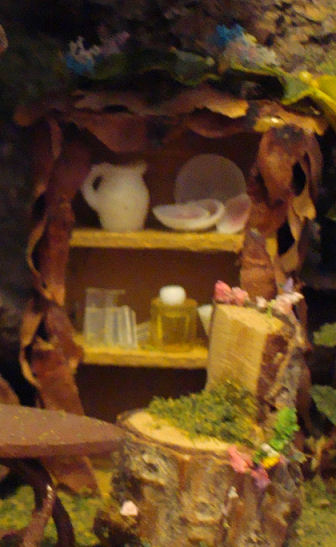
Some of the dishes in the pinecone shingled cupboard are made of tiny seashells.
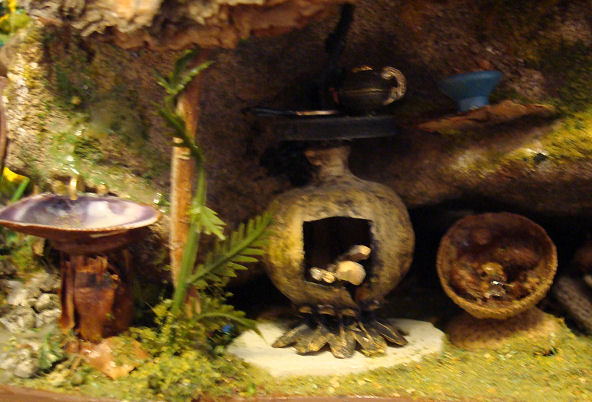
Here's the kitchen area. Food and dishes are washed at the shell sink. The post with the vine is a support for the roof over the kitchen area.
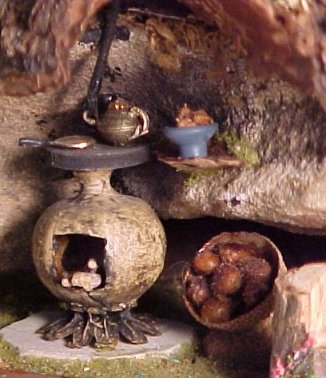
A stove made of an upside down poppy seed pod sits atop a slate base. Its stovepipe angles under the bark overhang and exits at the roof.
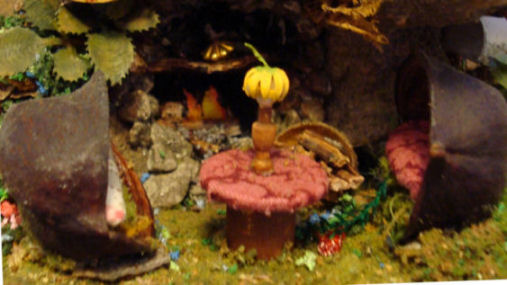
This is the sitting area around the corner from the kitchen.
My husband smiled. "I am not sure what that gold pot on the mantle is; maybe an urn with Great Grandpa's ashes?"
"Oh, good grief, dear," I groaned.
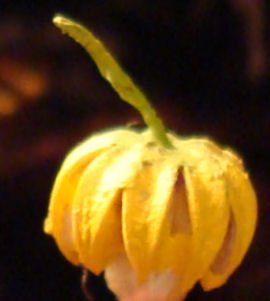
The lampshade sure looked like a painted seed pod turned upside down.
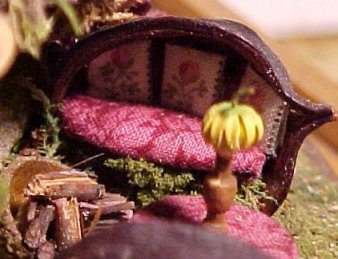
Here is a view of one of the sofas in the sitting area. It is also made from a bottle brush tree pod turned on its side. The wood in the acorn cap to the left is for the sitting area fireplace.
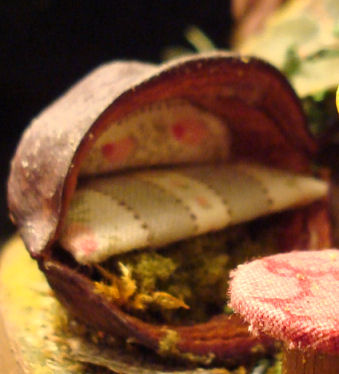
Here is a second sofa. Nice to curl up in one of these for a nap.
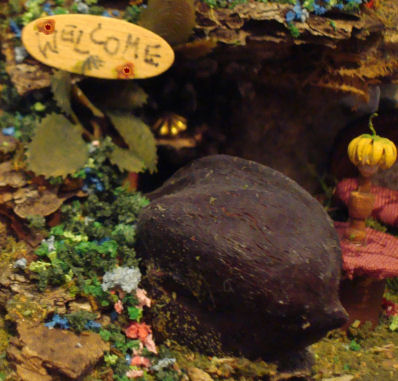
Here is the back of the pod sofa, the last of his pictures.
"Well, that's it," he said. "They were so friendly that I hated to leave (frankly, I got the impression they were kind of starved for conversation), but I know how you hate it when I stay up in the mountains after dark, so I said my goodbyes.
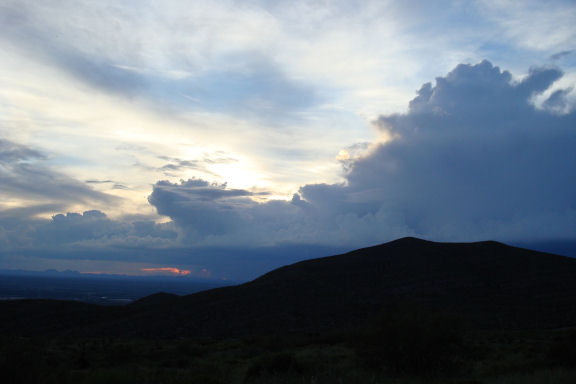
"I might've gotten a picture of them waving as I walked down the mountain, but the light was already fading rapidly, and I headed home."
"Well, hon," I said, hugging him. "You were right; I really did enjoy learning about this little family. I owe you big time for taking all these pictures for me on your hike, don't I?"
"Yep," he agreed, quite pleased with himself. "Modern technology is great, isn't it? I didn't figure I could do too much damage with a digital camera and I know you've been wondering if I would ever use it. Just don't assume this is going to be my usual practice in future, though. "
Well, we'll see, won't we?
................
NOTES:
(By the way, the two scenic photographs are ones I actually took in the park.)
This mouse house in a holey rock (the holes resulted from bubbles caused by volcanic activity eons ago) originated in a Pete and Jackie Steele workshop at a Southwest Roundup in Tucson, AZ. It was completed ten or twelve years ago, but I recently decided to update it. When I was working on Mother Goose's cottage, I was looking for an example of where I had used eggshells for stones. I remembered this project, which has always been one of my favorites, and was disappointed to see how much of the natural greenery had faded over the years that it has been in the entertainment center behind glass doors. So, I decided to refurbish the landscaping and finally tell the story of the little mice family.
It is approximately quarter scale, where one-quarter inch equals one foot. Most of the photos show things considerably bigger than they are in real life.

For example, here is Mama Mouse with a dime for comparison.
The Steeles provided a piece of volcanic rock from their property in Utah (you'd be surprised how heavy this scene is). We got to choose our rock, a base to set it on, thin slices of slate, large slabs of bark, twigs, and lots of natural materials and told to Have At It.
It was left to us to decide what our rocks would become. Some just landscaped with flowers and plants, others made fairy or elf habitats. Mine became a home for three cartoonish country mice (no more realistic mice for me after real mice invaded our pantry one winter). They were made by Beth Giachetti of Arizona.
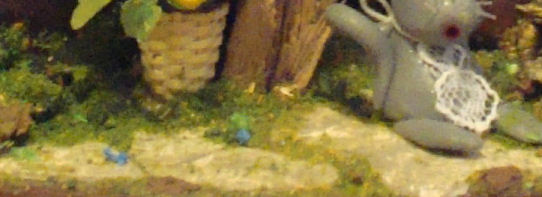
The rock entryway is made with eggshells. A clean empty eggshell is flattened onto an index card covered with glue. A stain is rubbed on, then off, and the excess card is cut away. I think this was two cards' worth of eggshells. (You can see this technique in process in the how-I-did-it for Mother Goose's Cottage.)
The steps were made with scraps of bark left from the roof piece, as are many of the shelves. Brown floral foam and cardboard pieces were widely used to prop up floors and build up layers, then covered with glue, sand and model railroad landscaping materials, along with dried flowers, lichen, mosses, etc. Unfortunately, much of the dried material did not hold up well over the years, except for the dried flowers in the acorn cup planter, which retained their color.
In those days my husband brought home all kinds of little dried plant material from his hikes, much of which I used originally for this scene. I also used items contained in a packet of simmering potpourri mixture, as well as pickling spices, etc. Some dried items held up extremely well over time; for instance, most of the pods; others did not.
The teakettle and skillet were made from tiny jewelry findings. The blue vase in the bathroom is a painted necklace fastener. The little blue bowl on the kitchen shelf is from a package of BPF, or brown plastic furniture. (You can investigate BPF here.) The cupboard was a quarter scale piece made from a kit; I added the pinecone shingles to make it look more rustic. The storage unit in the kitchen is made with two small acorn caps, one as basket, one as base; another acorn cap forms a planter by the front door.
The flames in the rock fireplace were cut from a magazine picture; the mantle is another small piece of slate.
I sawed the chair seats from some twigs. The table top is a little woodsie; its legs are pieces of grapevine. I stained it all to match.
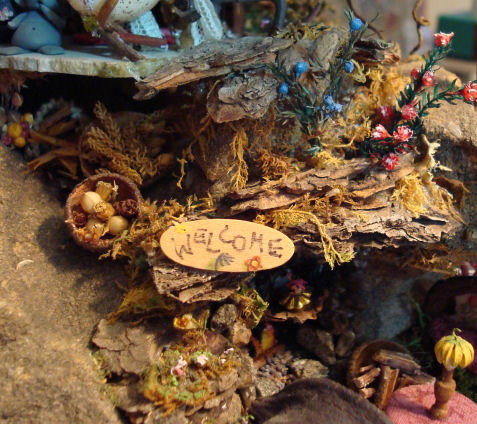
This was how some of the greenery looked when I got this down off the shelf.
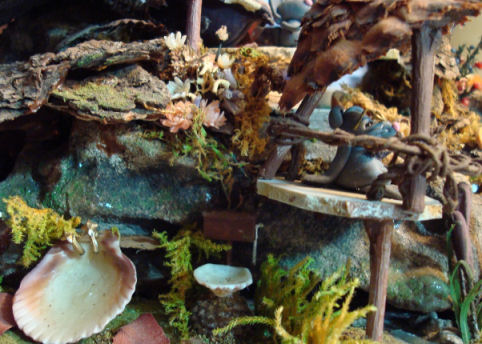
These are real ferns which I had touched with paint, and the yellow shows you where the paint wasn't applied! You might notice Papa Mouse's spectacles here; over the years they've gotten lost somewhere.
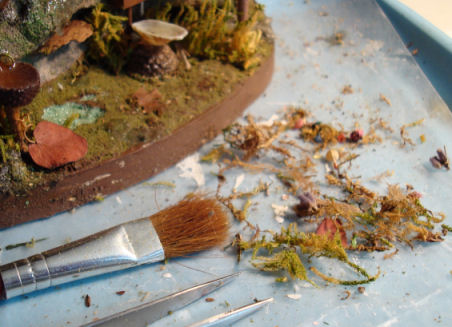
I plucked and pulled the old stuff out, then used a paintbrush to dust and sweep each section.
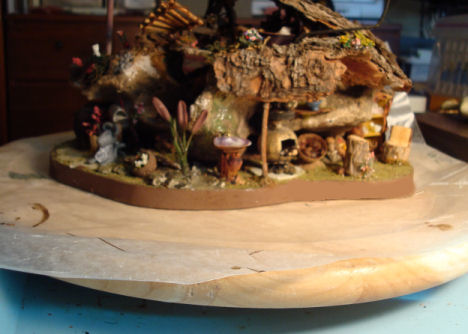
The rock that underlies this setting is very heavy, so I used a turntable for ease of turning as I worked on it, with wax paper underneath.
I'm glad I checked out that eggshell entryway; otherwise, this little setting of which I am so fond would have been a real embarrassment if I had gotten it out of the cabinet to show a visitor!
And at last I could tell the story of that mouse family in the Franklins!
NEXT: >>
